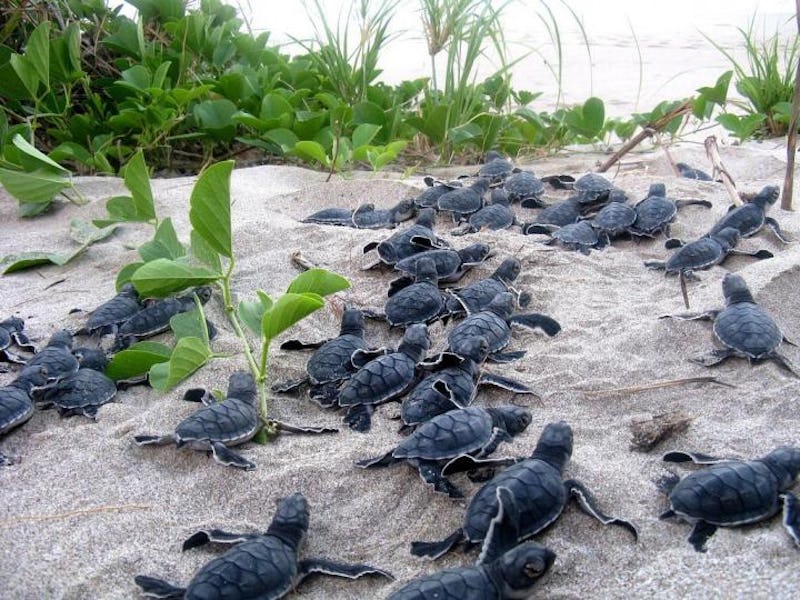Inspired by 'The Wire,' decoy eggs are saving an iconic animal from extinction

For turtles, just making it out the shell is good going. Predators like feral hogs and other reptiles make a meal out of turtle eggs. Others, like seagulls, eat turtle hatchlings before they reach the sea. We humans are part of the problem, too. Poaching has been devastating on turtle populations, like Leatherbacks in Costa Rica. In fact, life is so challenging for these iconic sea creatures, it is estimated that only one out of every thousand turtle hatchlings survive to adulthood.
But science is on the turtles' side.
Using decoy mechanical turtle eggs, scientists hope to not only leave individual poachers empty-handed — rather, they want to decimate a global criminal network.
A look inside the InvestEGGator.
These ingenious decoys are called InvestEGGators. Mocked up to look just like the real thing, the eggs are 3D-printed and embedded with GPS tracking devices. And while they don’t disturb actual sea turtle eggs, a new paper published Monday in Current Biology shows, they’re very effective at frustrating poachers.
Designed by scientist Kim Williams-Guillen, Director of Conservation Science with the conservation group Paso Pacifico, the decoy eggs were made for the United States Agency for International Development (USAID) Wildlife Crime Tech Challenge.
Put Breaking Bad and The Wire together, and you have the InvestEGGator.
In a statement accompanying the research, Williams-Guillen says she was inspired by two TV shows that have helped define 21st-century pop-culture: Breaking Bad and The Wire (it's not the first time these shows have been unlikely inspirations.)
“In Breaking Bad, the DEA places a GPS tracking device on a tank of chemicals to see who receives the chemicals. In one episode of The Wire, two police officers plant an audio device in a tennis ball to surreptitiously record a suspected drug dealer. Turtle eggs basically look like ping pong balls, and we wanted to know where they were going--put those two ideas together and you have the InvestEGGator," she explains.
A dozen decoy eggs together in a carton.
The study was led by Helen Pheasey, a postgraduate student at the University of Kent. To test the fakes, the researchers planted 101 of them in Costa Rica, where poaching has been devastating turtle populations.
Poachers took the bait. A quarter of the decoys were taken, enabling researchers to understand who was buying and selling these endangered creatures' eggs.
So, where did they end up?
The findings vary widely. One egg found its way into a residential property, where its tracker was disabled. Another went to a bar a few miles away from where it was taken. One decoy spent days in transit, traveling a little over 85 miles (137 kilometers) to a supermarket loading-bay, and then to another residential property. Rather than a sale, researchers assume that it was handed off at the property to a salesperson.
Baby turtles swimming, having escaped both predators and poachers on land.
But most of the eggs seemed to only move within a few miles of their original nest. The data are helpful, Pheasey says, because now investigators can focus “efforts on raising awareness in the local communities" to combat theft.
“It also means we know where the consumers are, which assists us in focusing demand reduction campaigns," she adds.
Individual poachers are often already known to local law enforcement. The real challenge is to disrupt the chain of purchases that comprise the entire underground market. The system is set up to enable new poachers to come and replace those who get caught. It’s in this endeavor that the InvestEGGator may prove most useful.
But simply arresting bad actors isn’t enough. Williams-Guillen notes that the decoys need to be used in the context of “a multi-pronged conservation approach that uses education, building better economic opportunities, and enforcement to help fight sea turtle egg poaching."
Perhaps with a TV-inspired invention drawing attention, there can be more promotion of the systemic changes needed to give turtles more than a one in a thousand chance.
Abstract: The insatiable human appetite for wildlife products drives species to extinction, spreads disease and has negative consequences for the economies of source countries. As a major transnational enterprise, illegal wildlife trade is valued between eight and 26.5 billion US dollars annually. Because law enforcement is often only reactive, information on trafficking routes is key to disrupting trade and curtailing wildlife crime. In our efforts to uncover trade routes of trafficked sea turtle eggs, we developed and field-tested the InvestEGGator, a 3D-printed decoy turtle egg embedded with a GPS–GSM transmitter. Illegally collected clutches of turtle eggs containing a decoy transmitter enabled us to track the movements of traffickers, and thus gain a better understanding of illegal trade routes. The decoys, set to emit a signal once an hour, provided five tracks, the most detailed of which identified an entire trade chain, covering 137 km. Using data provided by the decoys, we identified trafficking routes and on two occasions properties of potential interest to law enforcement. Decoys also yielded anecdotal information, furthering our understanding of trafficking routes.